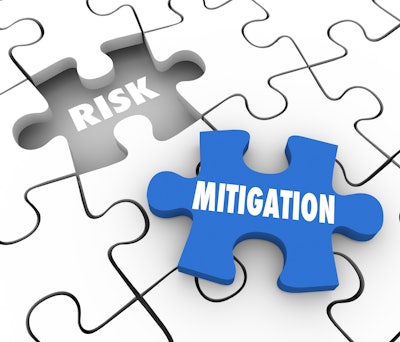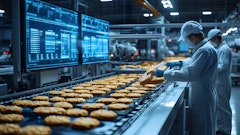
Disruption has always been normal in supply chains. From erratic weather patterns affecting crop yields to geopolitical conflicts rerouting trade lanes, food and beverage manufacturers face a constant barrage of challenges that strain supply chains and squeeze margins.
It’s not that disruptions are happening more often, it’s that they’re messier with greater impacts. Even if you ignore everything pre-2020, there have been ongoing geopolitical turmoil, tariff turbulence, and hyperinflation. These examples are just the next round of cyclical and identifiable patterns – that is, to those who have the visibility to recognize the signals. Soaring fuel prices, labor shortages, raw material scarcities, and unpredictable consumer demand are now part of the daily operating reality. According to a recent report, 83% of supply chain executives now rank resilience as critical as cybersecurity —a warning siren signaling just how widespread and persistent these issues are. But while disruption is unavoidable, being blindsided by it is not.
Blind spots and inaction: A risk you can’t afford to ignore
The greatest threat to supply chain resilience isn’t just the disruption itself—it’s choosing the wrong response to that disruption. That wrong response is inaction and instead opting for a “wait and see” method. This approach doesn’t effectively address the challenge of blind spots. Blind spots lurk in the hidden corners of the supply chain between disconnected systems, outdated data, or siloed partners. Choosing not to act is like trusting a GPS that won’t load your route—you might see the destination, but without visibility into how to get there, you’re setting yourself up for a detour, or worse, a dead end. The wrong move is pressing on blindly, hoping for the best. This is where these blind spots from outdated systems or siloed partners break that visibility. These gaps prevent decision-makers from spotting issues early, planning contingencies, or quickly changing course when things inevitably go wrong.
A recent survey found only 30% of global supply chain executives said their leadership had good visibility into supply chain issues—a sharp drop from nearly 50% in 2023. This decline in confidence suggests not just increasing complexity, but a growing disconnect between strategy and execution. In the food and beverage industry, where timing is everything and perishables wait for no one, that lack of visibility and action can be devastating.
Visibility and risk management go hand-in-hand
For companies in this industry, poor visibility isn’t just a data problem, it’s a risk management problem.
Without the ability to track inventory in transit, monitor production line performance, or receive early warnings from suppliers, manufacturers operate in reactive mode. Issues that might have been minor—like a delayed shipment or ingredient shortage—can quickly snowball into missed deliveries, loss of consumer trust, quality issues, or even product recalls.
For example, in 2021, a major cream cheese supplier suffered a supply shortage due to cyberattacks, pandemic-related issues, increased demand, and packaging material shortages. Unfortunately, it didn’t have the visibility to proactively prepare for these issues. This not only resulted in frustrated consumers but also inspired a campaign urging shoppers to avoid purchasing cream cheese to help preserve the supply.
These inefficiencies can quietly drain profitability and erode trust across the value chain. And because the warning signs are often hidden or delayed, it’s already too late to prevent the damage by the time leadership becomes aware.
The visibility advantage: Improvement in service, support, and delivery
To stay competitive, companies must rethink how they manage risk. They need to change from reacting to disruptions to anticipating them, which requires moving beyond disconnected tools and fragmented communication.
Instead, they need to build an integrated digital supply chain ecosystem—one where systems, partners, and people are aligned around a shared, real-time view of what’s happening. With this kind of end-to-end visibility, manufacturers can proactively identify risks before they escalate, make faster decisions, and course-correct in real time.
Seamless supply chains start with ecosystem integration
Adopting a cloud-based integration platform built specifically for dynamic, multi-partner environments is critical in the food and beverage industry. A modern integration solution should offer:
- Real-time visibility into key processes and transactions, from supplier deliveries to outbound shipments.
- Role-based dashboards that surface relevant insights to procurement managers, operations teams, and logistics coordinators alike.
- Proactive alerts and monitoring that flag delays, mismatches, or anomalies before they create downstream disruption.
By providing companies with the control and clarity they need, this connected foundation helps them reduce risk and improve responsiveness across their operations.
The payoff: Visibility, communication, and efficiency
The benefits of digital ecosystem integration go well beyond IT efficiency—they translate into real business outcomes.
- Visibility: By unifying data across suppliers, logistics providers, and internal systems, food manufacturers gain a centralized, real-time view of inventory levels, production statuses, and transportation movement. This clarity helps them identify issues early and respond with confidence.
- Better communication: A connected digital ecosystem enables faster, clearer collaboration between supply chain partners. Whether it’s flagging a shipment delay or coordinating a last-minute reroute, teams can share information instantly and act together.
- Efficiency: When visibility and communication improve, so does operational efficiency. Manufacturers can reduce errors, eliminate redundant processes, and better allocate resources. That could lead to fewer chargebacks, less spoilage, and faster shelf-to-consumer cycles—critical wins for a time-driven industry.
Staying resilient in an unpredictable market
There’s no escaping volatility in today’s supply chain environment, but the real cost comes from inaction. Food and beverage manufacturers can reduce their exposure—and even turn uncertainty into competitive advantage—by investing in real-time integration and visibility.
Ecosystem integration isn’t just a technical fix; it’s a strategic necessity for companies that want to thrive amid disruption. When partners, systems, and data are connected, decision-makers gain the foresight and flexibility they need to manage risk proactively.
For manufacturers seeking to improve their supply chain performance in 2025 and beyond, the message is clear: Know before it hits. Act before it hurts. That’s how the smartest organizations stay ahead of disruption.


















